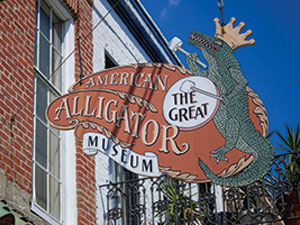A tribute to the 70-million-year-old creature attracts fans and curious guests to this New Orleans museum and shop.Tourists who love alligators and crocodiles will find gators in all their glory at the Great American Alligator Museum on New Orleans’ Magazine Street, famous for its eclectic vintage shops, variety of local retailers, artisan outposts and places to buy funky costumes.
This curious destination also includes a retail gift shop and wholesale business for goods related to “the fascinating alligator,” says Liz McDade, who owns the operation with her husband, Robert.
 The Great American Alligator Museum’s shop has everything gator under the sun, from gator-themed T-shirts and stickers to cute plush puppets. Photos: Lacy Davillier
The gift shop is packed with souvenirs, such as gator-themed salt-and-pepper shakers, ashtrays, dolls, watering cans, corn cob holders and motion-activated talking radio gators.
The idea to launch a museum in honor of the prehistoric family Alligatoridae was “fanciful and even optimistic,” and it came to fruition in April 2022. McDade shares the back story and what’s literally in store.
Q. What is the goal for the Great American Alligator Museum?
A. The museum’s guiding principle is to collect and preserve alligator artifacts that would be of interest to the public. So, we have a nearly 14-foot taxidermy alligator and a 50-million-year-old fossil of an alligator — one of two complete specimens in the country. We lent it to the Field Museum in Chicago for research and now it’s back. We have five rooms of alligator collections and an attached retail shop along with a dedicated crocodile room.
Q. Why are gator heads so plentiful and is there a demand for them?
A. When we noticed alligator heads at the open-air markets, we learned more about why we could even sell them. While alligators were almost extinct in the 1970s because they were being poached and hunted, Louisiana started a conservation program where they harvested eggs and took care of the alligators until they were 3 to 4 feet long so they would survive in the swamp and not be prey for birds and other predators.
“Alligators are scary and fierce but also cute. There is an endearing appeal to them.” — Liz McDade
In 35 years, the population went from less than 100,000 to multiples of millions just in this state. So, the state said, ‘OK farmers, you may harvest some and put a certain percentage back into the swamp.’ An alligator hunt can happen every year. It’s a combination of commercialism and environmentalism.
We sell the heads, backscratchers and key rings that are all byproducts of the farming process. People get excited about them! Alligators are scary and fierce but also cute. There is an endearing appeal to them.
Q. What unique souvenirs can guests find in the museum’s gift shop?
A. We have everything from plush to toys, prints, stickers, magnets, Christmas ornaments and T-shirts. We also carry Alligator King (our wholesale business) alligator meat snacks and hot sauces that come with a gator foot lanyap, a Cajun word for a little something extra. Children love the squishy and stretchy alligators, and we sell a crocodile dentist along with salt-and-pepper shakers, purses and everything alligator, really.
Q. What are some fascinating features at the Great American Alligator Museum?
A. You can’t miss the 14-foot alligator and prehistoric fossil. Our folk art room features pieces like a guitar with an alligator head mounted on it, a 4-foot basket woven into an alligator shape, and other art pieces.
We address the natural history side, as well, such as the difference between a crocodile and alligator and how old alligators really are. (They branched off from crocodiles 70 million years ago.) And we cover the whole gamut with museum pieces and retail products for people of all ages, from children who can barely pronounce the word alligator and say ‘agay’ to grandmothers who remember carrying an alligator purse. There’s something for everyone.
|



